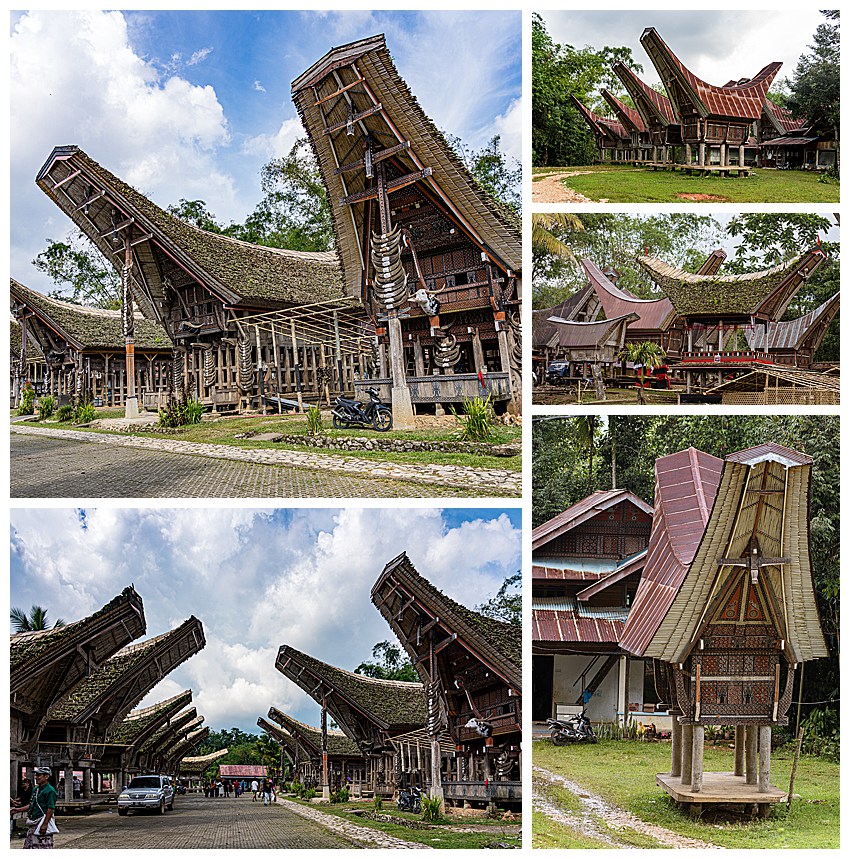
Tana Toraja, the highlands of Toraja, is known for their coffee, spectacular mountain landscapes, and its unique culture. The Torajan people is an ethnic group indigenous to the mountainous area and known for their elaborate funeral rituals, where death is celebrated. We will be going into the rituals they follow for death in detail over the coming days. Make sure your seatbelts are fastened, as the Torajan way of handling death is nothing like you have ever seen or likely even considered before!
Hanging coffins or “hanging burial” was one of the funeral practices practiced several hundred years ago in Toraja. The coffins, shaped like boats, were placed beneath overhanging cliff faces (center). These coffins were often guarded by wooden representations of the dead, known as tau-taus (bottom left). The Torajans believed that the higher the grave site, the closer the dead was to Nirvana, and the harder it was for thieves to access. This type of burial was reserved for the leaders of the tribe.

The traditional Torajan house is called Tongkonan, and the roof resembles the shape of a boat. There are three parts to the house: the the upper world (heaven) is where farming equipment is stored. The middle part is where humans live. The lowest level, called the underworld, is where the animals live. Animals are no longer housed in the lower portion of the house, for sanitary reasons, so that section is now generally left vacant.
Rice barns are also found near almost all Tongkonans, or group of such houses. Their external shape is nearly identical to the homes where the people live. The easiest way we learned to tell the difference was the support structure underneath. Rice barns have six strong pillars supporting them (lower-right), but are made from a material that is difficult for rodents to climb. Houses, on the other hand, have a more elaborate lattice framework supporting them.
The regency known as Tana Toraja is located in southern Sulawesi, the fourth largest island in Indonesia. 450,000 people live in Toraja. However there are more than a million Torajans worldwide. The majority of the people are Christian, though there is also a large Muslim population. Some people here believe in animism, which drives many of the traditions we will be describing in upcoming days.
Many Torajans worldwide return for funerals, and the entire family comes together at important social events. In fact, the funeral will not take place until most members of the family are present, which is why it is common to see the larger funerals in July, August and December (funerals are often postponed for months, or even years and decades after death). Smaller funerals are held year round.

The water buffalo is a status symbol representing wealth, fertility, courage and strength. The homes are often decorated with buffalo horns (top-left and top-right). The wealthier the family and the more generations in a home, the more horns are displayed. You can sometimes see jaw bones from recent buffalo sacrifices (middle-right). We learned that you can tell the age of the buffalo by counting the number of rings on its horns, much like determining the age of trees by counting the rings on the trunk. Buffalo are sacrificed after they are at least 3 years old, and after their horns have matured.

We visited the Bolu local animal market in Toraja. This market primarily sells water buffalo and pigs, for use in the various funeral rituals. Water buffalo are the ones with long horns and are always male, whereas females are called cows. Tens of thousands of water buffalo are needed each year for funeral rituals. Buffalo are expected to accompany the dead to the afterlife, and families go into debt to buy the animals in this bull market. Because of the shortage of buffalo, some are imported from other islands, such as Java, to fill the need. Buffalo for a funeral can cost anywhere from $1200 each for a small black buffalo to $3,000-$4,000 for an older bull (with longer horns), and up to $38,000 for a prized blue eyed Mercedes bull (mottled color with light color faces).
The funeral for a poor family has a minimum of 5 buffalo required to be sacrificed. Wealthier, or more prestigious families may sacrifice 50 or more buffalo for a single funeral. Some families may save for decades to pay for a single funeral. (Much more on this in future blogs)

Pig sacrifices are also a standard feature at all Torajan funerals, and some of the meat is eaten at the ritual meal, with the balance distributed to family and friends. An estimated 60,000 pigs are needed to fill this need annually, and many are purchased at these markets. A farmer will then tie the pig he has purchased to gift to the family onto the back of his motorcycle (center and lower-right). It is common to see live squealing pigs strapped to the back of bikes in the countryside during funeral season. Often, pigs are hoisted and carried with long bamboo poles (bottom-left).
1 thought on “Indonesia 22 – Toraja 1 – Death is Just a Part of Life”
Comments are closed.